
Anna Starobinets is a linguist, philologist, and contemporary Russian writer who has gained acclaim in the West Many of her books have been translated into several European languages, including English. . In 2018, Starobinets won the Hall of Fame Best Author Award from the European Science Fiction Society (ESFS).
Papmambook’s teenage correspondent Ksenia Barysheva sat down with Anna Starobinets to discuss her Beastly Crimes series Published in English in 2019 by Dover Publications, translated by Jane Bugaeva. and asked her about the particulars of writing mystery novels for children, the backstories for her characters, and the difficulties that were in store for an English translator.
- I’ve never liked children’s mystery novels—their villains seem so fake. They run badly, shoot poorly, and always seem to get outwitted. This isn’t at all the case for your Beastly Crimes series. The criminals are clever and cunning, it’s not easy to expose them, and that makes books impossible to put down. What would you say is the secret to a truly gripping mystery novel?
- When my eldest daughter was around nine, she asked me to find her some mysteries to read. I looked for children’s mystery books, but I didn’t like them either, and I had a whole different set of grievances. I don’t remember the titles of the books I found, but the plot consisted of, say, a picture stolen from a gallery, or some other theft to which I, as a reader, was absolutely indifferent. I didn’t feel that the characters were in any danger. So I decided to write a children’s book in the style of an adult noir mystery novel. Noir is a rather gloomy genre. What distinguishes it is that it has no good guys at all. All of the characters are bad to some degree, even those we root for as readers. According to the unspoken rules of mystery novels, the detective can’t also be the murderer, but in noir mysteries, he can be a very bad person, even if he’s not the killer.
I wanted to write a mystery novel for children, where someone would get killed, tormented, have their feathers plucked for real. I wanted it to be serious without terrifying children to the point of traumatizing them. That’s why I tried to make my mysteries more life-like and believable, even though the characters are animals. I never assumed that I should change anything just because it’s for kids, or that kids should only read about harmless crimes: a stolen picture or basket.... In that sense, I don’t mollycoddle children. I think children are quite capable of taking in information about real crimes. Any child knows that there are criminals, murderers, and maniacs out there. But I did try to tone down the level of barbarity. In the first Beastly Crimes book, In the Wolf’s Lair ISBN 9780486827629. , a chicken actually gets killed. The killing happens “offstage,” but according to the plot, the chicken really does die.
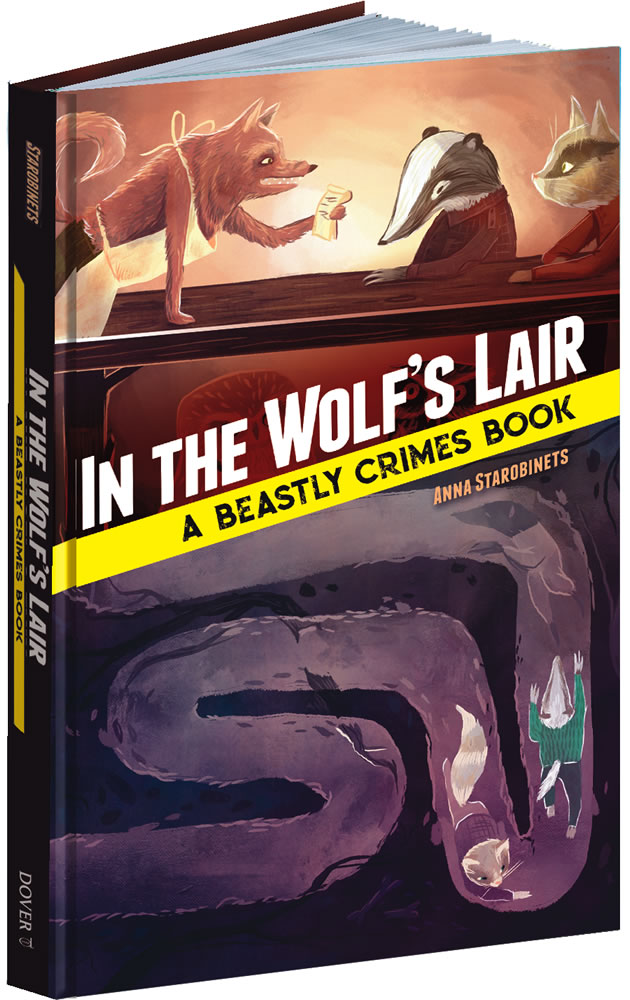
Image: doverpublications.com
- In your series, the Far Woods Police investigate truly awful crimes: fraud, murder, kidnapping. Did your publishers have any misgivings about the book? Were they worried there might be a backlash from parents and teachers?
- That is exactly why I had to break contracts with two separate publishers. One told me to change the title of the series from Beastly Crimes to Animal Mystery. Another proposed title was Cool Mysteries. The word “beastly” suggests brutality and violence, which are considered inappropriate for children. Children, after all, are delicate flowers and can’t handle such titles. I insisted that the novels be published as they were, because the titles are a play on words. The book’s characters are animals and they are violent. What happens in the Far Woods is truly beastly.
At the stage where we were discussing the contract and manuscript submission, there were also qualms about the mothito and raintini drinks which, as the publisher saw it, would sound to young readers like alcohol. As we all know, children have no idea that alcohol exists. But the mothito of the book is an infusion of fermented house moths. No actual restaurant would serve you such a beverage, or include it in their cocktail menu.
I didn’t like the illustrations the publishers suggested either. They looked too childish. The fox wearing lapti [Russian peasant shoes] looked like the one from [the folktale] “Kolobok,” which is for very young readers. In one book of the series (A Predator’s Rights ISBN 9780486829517. ), the protagonist, Fox, wants to go back to her “roots” by breaking the law about not eating animals. She wants to start eating chicken. There’s no way a character like that goes around in lapti and a little head scarf! In the end, I found publishers with a sense of humor, which was precisely what was needed to come to terms with my title and the noir-style illustrations I had in mind. I may have missed something, but since the book came out, it’s been read by children, parents, teachers, and librarians, and I have yet to hear anyone say “you’re scaring our children” or “you’re encouraging alcohol consumption.”
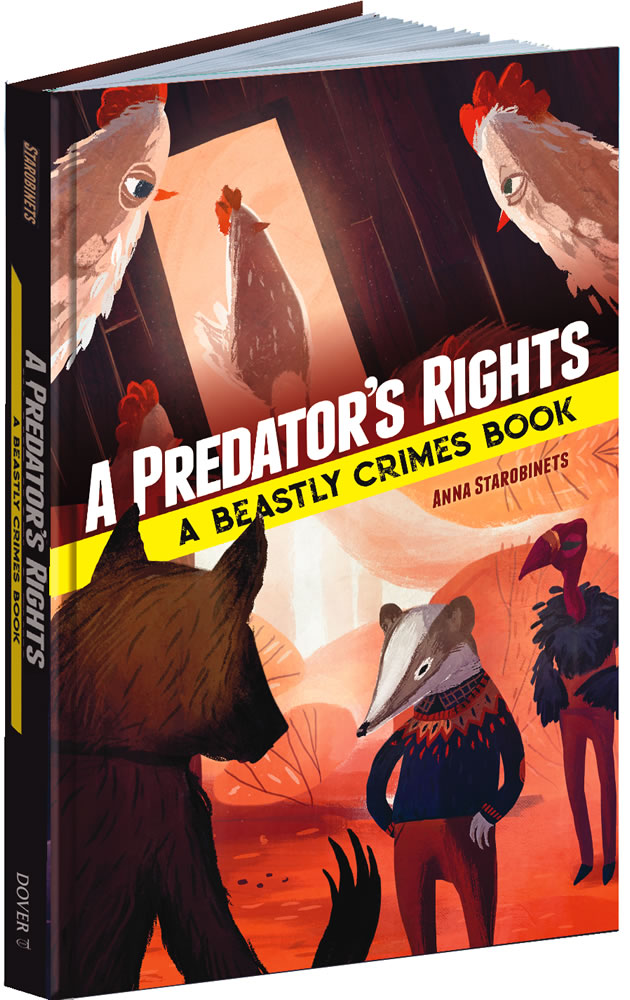
Image: doverpublications.com
- The book actually has illustrations that are very scary: eyes that glitter in the dark, huge silhouettes that take up the whole page. How did those come about? Why, do you think, do children enjoy getting just a little bit scared?
- Marie Muravski is the artist behind the illustrations. I love her work. The pictures are in line with what I think they should be. The text demands dark, grotesque, adult visuals and I envisioned something that was both noir and comic-book-like. The comic book genre allows the artist to depict animal characters as anthropomorphic or human-like—though not childish—to fit the genre. The word “noir” itself means “black” in French. In films of the genre, there’s always low lighting and dark shots. A common frame shows a person with bar-like shadows across his face. As soon as you see that image, you understand that this person will turn out to be the criminal. I think one of the Beastly Crimes books has an illustration just like that. These are exactly the kind of pictures I wanted, “with bars.” Marie Muravski and I understood each other.
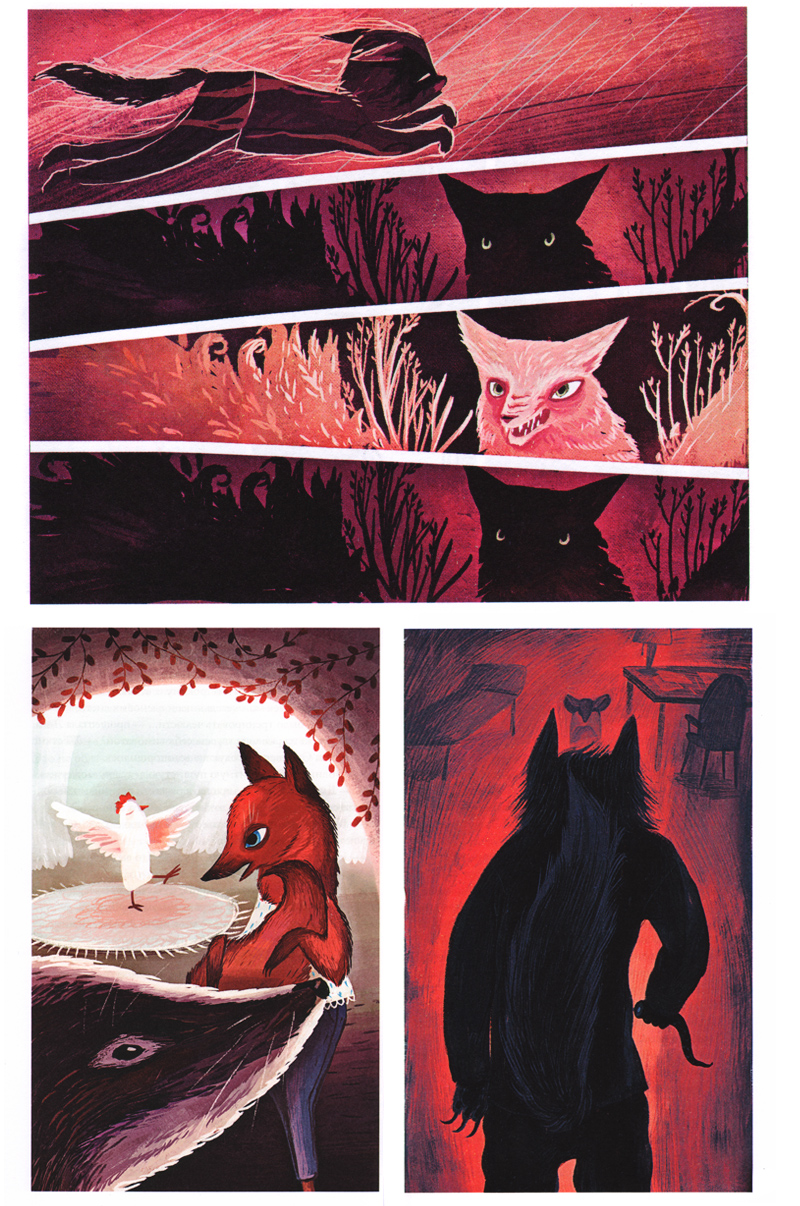
I wouldn’t say that the illustrations are all that scary—they’re unsettling and ominous. They generate a sense of suspense, of anxious expectation. Adults, as well as children, love suspense and the excitement it generates.We’re scared but not scared to death. We’ve frozen in fear, certain that we’ll be stuffed in a bag and dragged away (a very unpleasant feeling). Yet, at the same time, we’re outside the situation—someone else gets stuffed in the bag and we’re just observers. On a hormonal level, we experience a rush of adrenaline, and our pulse quickens. But it’s important that this not go on for too long. If you subject your reader, whether a child or an adult, to an anxious state, you need to measure it out, limiting it to a couple of pages. Then you need to free the reader from that feeling and let him experience something else. Relief, for example: the protagonist makes it out. Or sadness, sympathy—if anything does actually happen to the hero. What’s important is not leaving the reader in a state of fear for too long.
- When I was reading In the Wolf’s Lair, the first book in the series, I kept feeling like there was a director behind all the awful crimes in the Far Woods, someone who plants criminal ideas in the characters’ minds and then watches how they play out. Was there such an animal in the Far Woods?
- No, there’s no such character in the Far Woods, no personified evil that’s the puppet master behind all the villains. In the Beastly Crimes books, there are a lot of allusions, including references to Sherlock Holmes and Dr. Watson. In Arthur Conan Doyle’s stories about Sherlock Holmes, there’s a Professor Moriarty, who is behind practically all of the crimes committed in the books. I don’t like such characters at all, since it oversimplifies the conflicts. Life has no director and that’s what makes it so varied. When there’s one main villain, that makes everything too one-dimensional and obvious, at least for me. In Beastly Crimes, there are Lawyer Owls, who are mini-Moriartys of sorts. They come out and orchestrate things periodically, but at the same time they’re inadequate, they don’t measure up as real villains. They’re somewhat stupid, they’re small-minded...too irritable, too dusty. On purpose, and as a matter of principle, I chose not to have an overarching villain.
- Why are the main characters of the Beastly Crimes books animals that don’t have any animal superpowers, the strength of a bear or the agility of a panther, for example?
- Actually, there is such a hero. In the last book of Beastly Crimes, there’s Super Bat, a special agent bat with superpowers.
- But in the end, it turns out that she’s wrong, and the crimes are solved by good old Chief Badger.
- A reader should love the protagonist. Well, maybe “should” isn’t quite the right word, but since we’re talking about a book series, it makes sense. We should grow attached to the main character, and for that to happen, he should be interesting and make us feel sympathy, as well as awe and respect. There’s no love without sympathy. If the lead investigator of the Far Woods were to have claws, fangs, scales, if he were invincible, indomitable, and on top of all that extremely smart, we wouldn’t find him interesting. We wouldn’t feel any sympathy for him. What makes a character interesting is his or her flaws. This is incredibly important. The best protagonists of the best books all have flaws. Let’s step outside the mystery genre for a second, and take Lord of the Rings, for example. A character like Frodo comes across as a bit pitiable at first. Hobbits are bourgeois, they like good food, they dream of arranging the cups on the shelves of their cozy homes, instead of going on a distant quest to save the world. We feel for this chubby, cozy little character. He wants to drink tea with crumpets, but sets off on a journey that spells certain death. And yet we understand him. In this way, it’s easier for us to relate to the hero, because we ourselves aren’t heroes in the least.
We don’t have scales, armor, claws, or fangs. And when we see a hero like this, who is heroic in spite of himself, we love him much more and empathize with him more. This works for mysteries too. There’s a mystery series by the Norwegian writer Jo Nesbø. The detective of his series is an alcoholic. He investigates serious crimes, but he has this weakness. It’s not that we forgive him his alcoholism, but we accept him with his peculiarities and feel for him. We worry when he enters a bar—will he stop at that tomato juice or will he fall off the wagon again? And then will his lady love leave him again, and will his investigation fall apart? This hero is always on the verge of a breakdown, and so we are much more attached to him than we would have been had he been perfect. You don’t worry about those that are perfect—they’ll be fine.
Same goes for the Beastly Crimes series. Chief Badger is old and fat, and he’s often out of breath. He’s always thinking about going into hibernation. He can barely keep up with his job—he struggles to run. He pants when he walks. He can’t resist having a whole Bump on a Log before bed because he’s a glutton.
Badgercat, elegant and graceful as he is, lives with an inner struggle. He can’t decide whether he’s a badger or a cat. He’s in a constant state of identity crisis and that makes him very nervous. We empathize with these two characters, we love them. If they hadn’t had any flaws, if the heroes were to be a strong bear or graceful cat, we would have loved them less.
- In The Plucker ISBN 9780486829531. , Ratty lays out the tenets of his personal philosophy: “A real rat lives life as if its heart has already been ripped out.” and “Don’t have a shadow—be a shadow.” Badgercat, the Assistant Chief Badger of the Far Woods, is impressed with his new friend. Why does this philosophy appeal to him?
- I slightly reworded sayings from the Japanese samurai code. There’s a belief that a samurai should live as though he has already died. It’s a code of fearlessness. If you are already dead, you aren’t afraid of death. I endowed Ratty with this samurai code. Ratty is the opposite of Chief Badger. Chief Badger is an animal, of course, but I wanted to make him more human, or should I say, “more badger.” He’s somehow relatable, warm, fuzzy, soft. Ratty is tough, he’s cynical, he’s seen it all. He has an ugly naked tail. Chief Badger and Ratty are wise in their own ways.
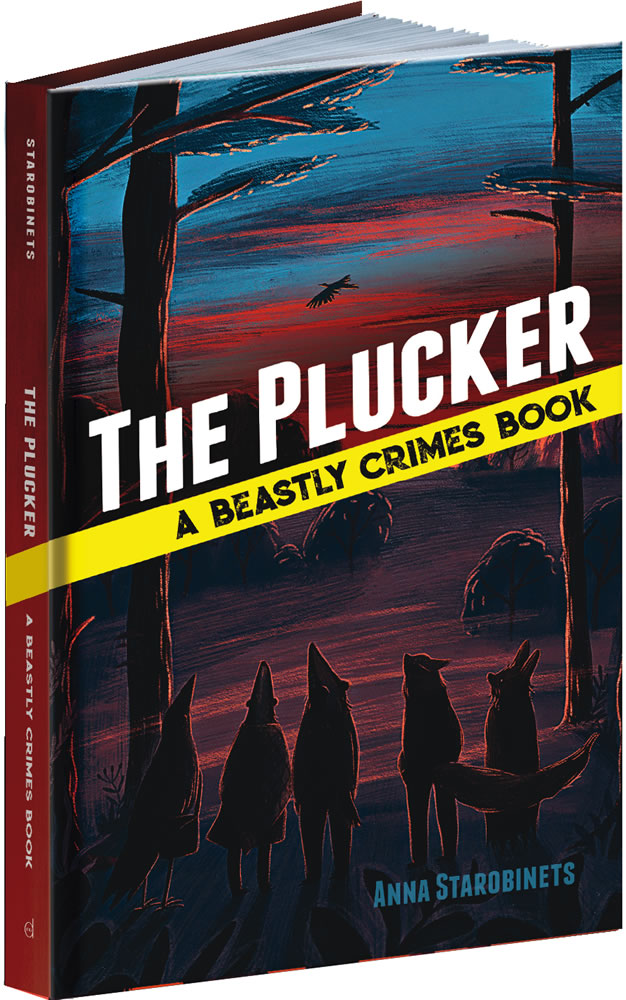
Image: doverpublications.com
When Badgercat thinks that everyone has turned away from him and betrayed him, when his beloved cat has dumped him and he’s failing at everything in his life and he reconsiders his values, he lets himself get much closer to the one who is the complete opposite of his adoptive father, Chief Badger. It’s an act of desperation from Badgercat, because the only one who will associate with him is the hard-hearted and cynical Ratty, who also ends up being a traitor.
- At the end of The Plucker, we learn that all the crimes were committed in a quest for immortality. J.K. Rowling’s villain Voldemort made Horcruxes for the same reason. Do you think trying to gain immortality is a trait common to villainous characters, dictators, and tyrants?
- J.K. Rowling, for whom I have the greatest respect, borrowed many mythological elements whole. A leader who dreams of immortality is an ancient archetype, a worn cliche. You’ll find this mythologeme in Russian folk tales, too. In The Plucker, I have my own allusion to Pushkin’s Russian folk tales—the “Ballad of the Mad Hamster,” who bathes first in water, then in milk, to regain his youth. In real life too, many dictators have been obsessed with this issue of eternal life. Under many totalitarian regimes, there were special divisions of scientific laboratories, where they conducted experiments to extend the human lifespan. At one point, as a journalist, I was interviewing two geneticists at the Russian Academy of Sciences. They said that our government was also interested in such research and that there were government-run labs where they studied immortality. I asked how far they’d gotten. They said there was some progress, that they had gotten mold to live longer. So this theme is an obvious one. What more could an evil ruler want, once he has money, power, love from his subjects (maybe fake, but sometimes, quite sincere)? What’s left is living longer, so that you can enjoy what you have forever.
- In The Plucker, Sarah, a white raven, refuses to take off the metal ring that the raven exterminators, who wiped out all the other white ravens of the Far Woods, put on her ankle. Barbara the badger refuses to get therapy after being assaulted. They’re both proud of what they’ve survived. Do you think it’s important to remember the violence one experiences?
- I don’t know how clear this was, but Sarah the white raven is a reference to the Holocaust. At least, that’s what I was hinting at.
- I saw it as a reference to Stalin's purges.
- That could be another way of understanding it. I was speaking of the extermination of a large number of people based on a shared trait. People who didn’t deserve this in any way, who had never done anything wrong. Psychotherapy doesn’t presume to make you forget what happened. It allows you to learn to live with it and move on. Forgetting or pretending nothing happened is a lack of respect for those that died. It’s self-deception. Forgetting such things, or pushing them deep inside is impossible. Sarah is maybe honoring the memory of her kind in a grotesque, caricatural way, but she does want to be sure they are not forgotten. Modern Germany has many museums dedicated to the victims of the Holocaust. Preserving the memory of past events is important so that we don’t repeat the mistakes of the past. If you cross those events from your memory, they can all repeat several years later.
- In A Predator’s Rights, Wolf acts as a peacekeeper. Do you have to be a Wolf to bring peace?
- I wanted to play with literary templates. So many children’s stories portray the wolf as the bad guy. In the first part of Beastly Crimes, as soon as there’s a crime, the Wolf is automatically suspect. I wanted to make this character much more complex, for him not to do what was expected of him and to do what nobody could have predicted.
- In Beastly Crimes there is a lot of onomatopoeia. Did you study the language of animals while writing the book?
- Many characters certainly have very particular ways of talking. For example, the coyote laughs. There’s this line you often see in adventure novels: “The coyote’s laugh echoed over the swampland.” They have this hysterical laughter. I needed a character who would be hysterical and a coyote fit the bill perfectly thanks to his unique laughter. The Magpie’s voice crackles at the right moments, and the Warbler speaks in his own way.
- The main characters of both Beastly Crimes and Catlantis Most recent English edition: NYR Children's Collection, 2016. ISBN 9781681370002. , Badgercat and the cat Baguette, respectively, are orphans. Is that a coincidence? Both Beastly Crimes and Catlantis have a certain mythology, origin stories and legends that are passed down through the generations. And Badgercat and Baguette don’t have that.
- When you make a character an orphan you make him a little flawed and deeply unhappy. He doesn’t have an important part of his identity, which has to do with parental love. He’s missing a part of his soul, a chunk of his past. That carries into the present, where the character acts in a particular way. Such a character is convenient for an author. He’s nervous, short-tempered. The subject of childhood makes him anxious. In some situations, he might lose it completely and act impulsively.
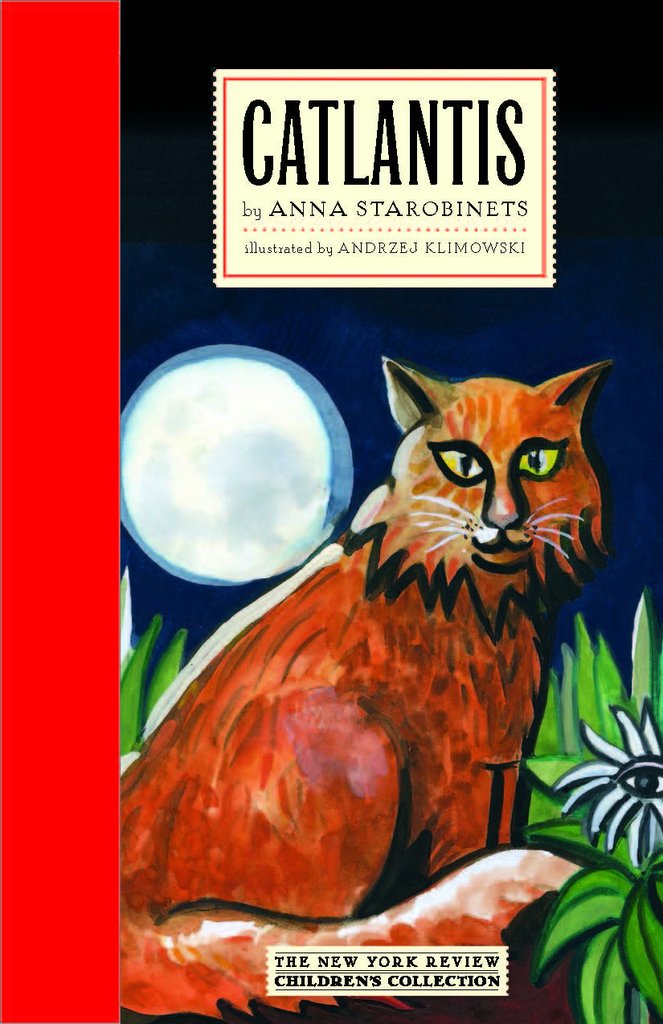
Image: nyrb.com
As for the origin stories, every story demands to be told. If you’ve created the world, you have to tell readers about it from the very beginning. Every writer is a bit of a demiurge, a divinity that creates worlds. Of course, if you’re writing a short story about a kitten abandoned in a forest, you don’t have to write an origin story. But if you set out to write an epic saga, its world demands a foundation. In Beastly Crimes, there’s no origin story as such, but by the fourth book, this mystery series led me into geopolitics. I needed to explain how the world was organized in terms of its government and power structures, about the Union of Mixed Woods and its leaders. In Beastly Crimes, different animals have different religious beliefs. And since it’s a saga, you need to explain what the characters believe in, how they live, what they eat. The world is very well thought-out. They even have art exhibits in the Far Woods.
- Every time he dreams of retiring, Chief Badger says that life was lived in vain. He wasn’t able to eradicate crime, he doesn’t have a family.... Is this what every smart Badger’s life adds up to?
- Badger says this at a moment of desperation. He’s usually able to get out of this state—a few times in each story, actually. But, I think you’re right, this level of self-reflection is usually the fate of very intelligent, highly-organized animals, including people. It wouldn’t even occur to a person with a low intellect, who might think: “That’s it, things are bad” then go binge on Bumps on Log, or get drunk on mothitos. Self-reflection, analysis of what’s going on around you—these are experiences common to intelligent people. When you start to assess a situation in the moment, when you’re not well and you’ve suffered setbacks, you could come to very sad conclusions, but you’ll still come out of that state. In Beastly Crimes, there’s this character—a coyote called Yote. He’s hysterical, he’s traumatized from childhood and doesn’t self-reflect much. Instead of analyzing a situation and finding a way out, he becomes hysterical, he yells and yelps, whimpers, wails, and laughs. So not all the animals of Beastly Crimes process what they feel or contemplate the meaninglessness of life.
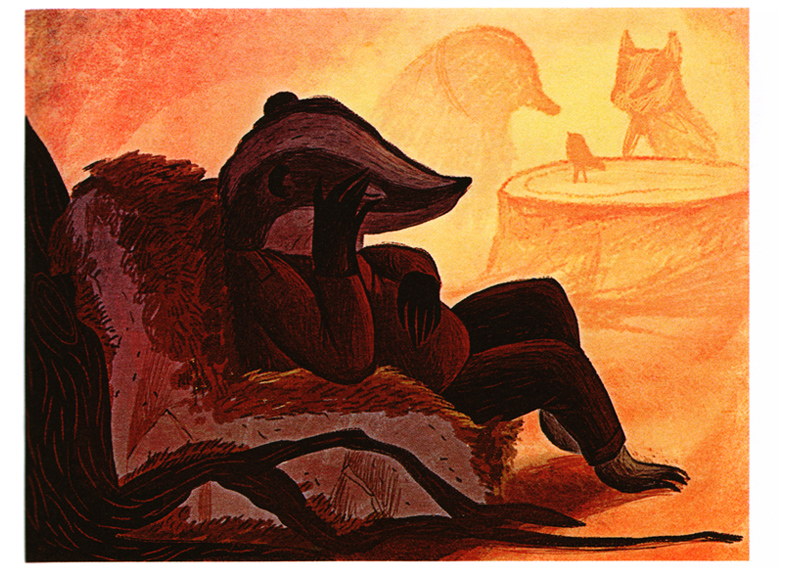
- In A Predator’s Rights, the pack of dogs change their mind depending on who is leading them. Can literature teach us not to follow the crowd?
- I don’t really like when literature is out to teach something—I’m not a fan of that kind of didactic tone. But among literature’s challenges is putting a mirror before its readers, so that they can see their reflections. We can really see ourselves in those dogs. We often behave like conformists, agreeing with the proverbial flock. Everyone barks, and we bark too. When we recognize ourselves this way in a book, it doesn’t feel good, and I think that can be useful.
- Is Noir, the cat from Claws of Rage ISBN 9780486829524. , the same cat who’s the protagonist of Catlantis? Why does a writer sometimes choose to have characters from one story reappear in another? Is the character a sort of talisman?
- Yes, it’s the same cat. I can’t explain it. He’s such a great little cat, and I wanted him to live on in another book.
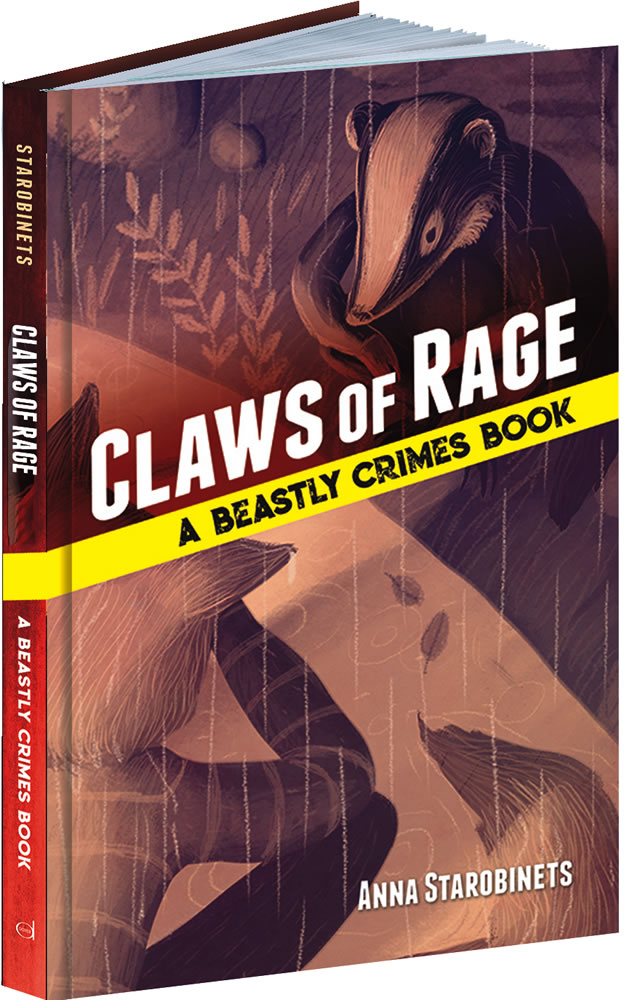
Image: doverpublications.com
- Catlantis was translated into English, but it has a lot of wordplay. How did that come through in the translation?
- In terms of wordplay that had to do with cats, it was all pretty simple. The English “cat” sounds a lot like the Russian “kot.” So “Kotlantida” is translated as “Catlantis,” which is convenient. After the book was published in Great Britain, Catlantis was named one of the best books on lists put out by British newspapers in time for the New Year. All the other books on the lists were originally in English, so Catlantis was actually the only book in translation that earned a spot on the lists. That speaks to, among other things, the quality of the translation.
Now Beastly Crimes is also out in English. There’s a lot more wordplay there than there was in Catlantis. I’ve just started reading In the Wolf’s Lair in English, but I don’t know the language well enough to evaluate the translation. I like how certain things were done, but others don’t sound quite right. For example, there’s a play of words with the Suchok bar [“bar Suchok” in Russian, meaning ”tree knot bar;” “barsuchok” (one word) means “little badger”]. The translator may not have caught that, or may not have been able to come up with an equivalent. In English, the establishment is simply called the Tree Knot Tavern. Maybe there’s something there that I missed.
- In Beastly Crimes there are also allusions to Russian literature, such as Mikhail Bulgakov’s The Master and Margarita or Boris Vasilyev‘s novel The Dawns Here Are Quiet. Do you think English language readers will get those references?
- Yes, they’re there, but they’re more for the parents who will be reading the mysteries with their kids, so that they also enjoy the books. These references may be lost on readers of the English version. Part of the meaning is inevitably lost with translation.
- When Catlantis is destroyed, the gods grant different cats different magical powers—the ability to see the future, read minds, travel through time or space....Which of these powers would you like to have?
- You always make the main character somehow most like yourself. Like the protagonist, I would most like to be able to time travel.
- In your literary workshop you teach essay writing in a way that casts aside the traditional school formula for essay writing. Did you enjoy literature class at school?
It depended. I was in two different schools. At first, I attended a regular school, with an emphasis on English language. Then, in eighth grade, I transferred to a lyceum. It’s called School No. 1535 now—before it was known as the Lyceum at the Institute of Asian and African Studies. We had absolute freedom there, and I enjoyed history and literature classes. We were taught to look at the same event and the same person from different points of view and teachers valued my writing abilities. My essay writing got me through most of my subjects, except for chemistry, where we didn’t have to write essays. I was cheating in a way. My ability to write in an interesting way about any topic disguised the fact that I knew nothing at all about the subject itself. At the first school, we had had typical literature classes, taught according to the standard curriculum, which drove me crazy. It was very boring, because you’re simply getting shoved into an algorithm, which, practically speaking, is not very applicable. I talk about this in the introductory part of my essay writing class: the school’s typical approach doesn’t have anything behind it. It doesn’t help to explore the subject, and the conclusion for a classic school essay simply repeats the introduction and the given topic.
Interview conducted by Ksenia Barysheva
Photograph courtesy of Anna Starobinets
Translated from the Russian by Alisa Cherkasova
Read Papmambook's teenage authors' reviews of the Beastly Crimes series.
Follow us on Facebook.


Ksenia Barysheva, “Book Expert of the XXI Century” contest winner, Papmambook teen editorial staff, 15 years old
